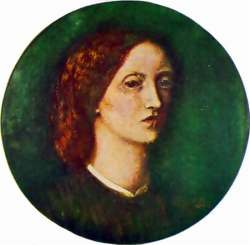Elizabeth Eleanor Siddal, better known as Lizzie Siddal, was an English poet and painter, however she is better known for being the model of famous paintings of the Pre-Raphaelite Brotherhood, such as Ophelia by Millais.

Siddal was named after her mother. Her parents were Charles Crooke Siddal and Elizabeth Eleanor Evans. At the time of her birth in 1829, her father had a cutlery-making business, but around 1831 the family moved to a less salubrious area in south London, were the rest of Siddal siblings were born. Although there is no record of Lizzie Siddal attending the school, she could read and write, presumably having been taught by her parents.
The Model
Siddal showed her own drawings to Walter Deverell’s father in 1849, while she was working at a dressmakers and millinery shop in Cranbourne Ally in London. And he suggested that she should model for Walter. She was employed as a model by Walter Deverell and it was through him that she met the Pre-Raphaelites.

At the time, Deverell was working on a large painting that depicted a scene from Shakespeare’s Twelfth Night, showing Orsino, Feste, and Viola as Cesario. Like other Pre-Raphaelites, Deverell took his inspiration and forms from life rather than from an idealised or antique figure. So, he based his Orsino on himself and Feste on his friend Dante Rossetti. This was the first painting for which Siddal sat.

In 1852, while posing for Millais’s Ophelia, Siddal floated in a bathtub full of water to represent the drowning Ophelia. Millais painted daily into the winter putting oil lamps under the tub to warm the water. On one occasion the lamps went out and the water became icy cold. Millais was so absorbed by his painting that he did not notice what happened and Siddal did not complain. After this she became very ill with what was probably a severe cold or pneumonia. Siddal’s father held Millais responsible and made him paid her doctor’s bills under the threat of legal action.
Siddal was Dante Gabriel Rossetti’s muse and main model throughout most of his youth. They met in 1849, while she was modelling for Deverell. Two years later she was modelling for him for the first time. Rossetti began to paint her excluding almost all other models. He even stopped her from modelling for the other Pre-Raphaelites.

It is said that the number of paintings and drawings that Rossetti did of Siddal are in the thousands, but undoubtedly the most famous is his Beata Beatrix, in which he depicts Dante Alighieri’s Beatrice praying. It was painted in 1863, a year after Siddal’s death.
Poet and Painter
Siddal’s work as an artist and a poet was important and influential. She developed a love poetry at a young age after discovering a poem by Tennyson, which served as inspiration to start authoring her own poems.
In 1852, Siddal began to study with Rossetti. At the time she painted a self-portrait, which differs from the idealised beauty portrayed by the Pre-Raphaelites. Three years later the art critic John Ruskin began to subside her career and paid £150 per year in exchange for all the drawings and paintings she produced. She produced many sketches, drawings, and watercolours as well as one oil painting.

Her sketches are laid out in a fashion similar to Pre-Raphaelite compositions illustrating Arthurian legends and other idealised medieval themes, and she exhibited with the Pre-Raphaelites at the summer exhibition at Russel Place in 1857.
Gone
o touch the glove upon her tender hand,
To watch the jewel sparkle in her ring,
Lifted my heart into a sudden song
As when the wild birds sing.
To touch her shadow on the sunny grass,
To break her pathway through the darkened wood,
Filled all my life with trembling and tears
And silence where I stood.
I watch the shadows gather round my heart,
I live to know that she is gone –
Gone gone for ever, like the tender dove
That left the Ark alone.
During this period Siddal also began to write poetry, choosing often dark themes such as lost love or the impossibility of true love. According to the critic William Gaunt “her verses were as simple and moving as ancient ballads; her drawings were as genuine in their medieval spirit as much more highly finished and competent works of Pre-Raphaelite art”.

In 2018, the exhibition Beyond Ophelia examined Siddal’s career, artistic style, subject matter, and the prejudice she faced as a female artist whilst also examining the Manders of Wightwick as pioneering collectors: Rosalie Glynn Grylls and Geoffrey Mander paid a record sum for her work in the 1960s and gave it to the National Trust.
Beyond Ophelia was curated by the National Trust Assistant Curator Hannah Squire, ran at Wightwick Manor and featured 12 artworks created by Siddal and owned by the National Trust. It was the second exhibition on her work (the first one was curated by Dr Jan Marsh at the Ruskin Gallery in 1991).
Curiosities:
- Siddal posed as a model to Walter Deverell, William Holman Hunt, John Everett Millais and her husband Dante Gabriel Rossetti.
- Significant collections of her work can be found at Wightwick Manor and the Ashmolean.
- It was Rossetti who changed the spell of her family name, originally Siddall, by dropping the second “l”.
- Though she was later praised for her beauty, Siddal was originally chosen as a model for her plainness.
- Siddal and Rossetti were married in 1860 without their family and friends, just a couple of witnesses whom they had asked in Hastings.










You must be logged in to post a comment.